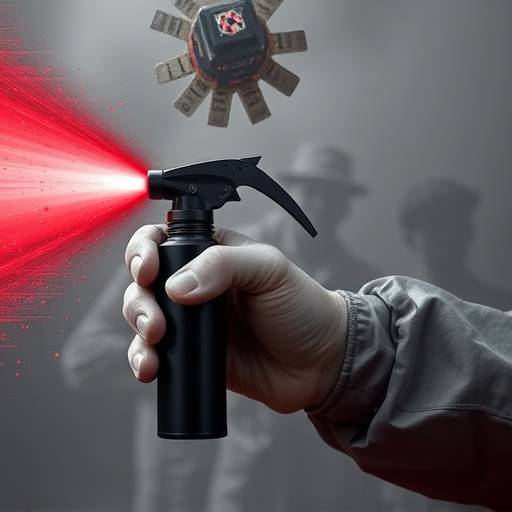Bear spray and personal pepper spray, both using capsaicin, differ in purpose and application. Bear spray deters bears with high-concentration capsaicin, while personal pepper spray targets human threats with a tailored formula for close-quarters combat. Personal pepper spray offers ease of use and portability, making it ideal for self-defense scenarios. Choice depends on intended use, active ingredients, weather conditions, and individual safety considerations.
In the face of potential threats, self-defense tools like bear spray and personal pepper spray have emerged as powerful allies. This article delves into the world of these defensive mechanisms, focusing on their respective roles in protecting individuals. We explore the natural defense of bear spray, its active ingredient oleoresin capsicum, and how it compares to modern personal pepper spray. By understanding their effectiveness and safety considerations, readers can make informed decisions, choosing the right tool for their protection needs, whether in wilderness settings or urban environments.
- Understanding Bear Spray: The Natural Defense Mechanism
- Personal Pepper Spray: A Modern Self-Defense Solution
- Comparison: Effectiveness and Safety Considerations
- Choosing the Right Tool: Factors to Affect Your Decision
Understanding Bear Spray: The Natural Defense Mechanism
Bear spray and personal pepper spray are both defensive tools, but they serve different purposes and have distinct mechanisms. Bear spray, as the name suggests, is specifically designed to deter bears, primarily black bears and grizzly bears, which can pose significant threats to humans in their natural habitats. It’s a natural defense mechanism that uses capsaicin, the same compound found in chili peppers, but in much higher concentrations. This chemical irritates the bear’s eyes, nose, and respiratory system, causing them to retreat.
In contrast, personal pepper spray is more versatile and commonly used for self-defense against various threats, including humans. It also utilizes capsaicin but in a different formulation tailored for direct human interaction. The effects are similar to bear spray, causing temporary blindness, coughing, and difficulty breathing, but it’s primarily aimed at deterring aggressive individuals rather than wild animals. Understanding these differences is crucial when choosing between bear spray and personal pepper spray based on one’s needs and the potential threats they face.
Personal Pepper Spray: A Modern Self-Defense Solution
Personal pepper spray has emerged as a modern self-defense solution, offering individuals a non-lethal yet effective way to deter potential threats. Unlike bear spray, which is designed for outdoor encounters with aggressive animals, personal pepper spray is tailored for close-quarters protection against humans. This specialized product contains capsaicin, the active ingredient found in chili peppers, which irritates the eyes and respiratory system when inhaled.
The key advantage of personal pepper spray over bear spray lies in its ease of use and portability. Designed for self-defense scenarios, it typically comes in compact, easy-to-carry cans that can fit comfortably in pockets or bags. This accessibility allows individuals to be proactive about their safety without sacrificing mobility or convenience. Whether for personal protection during late-night walks or as a precaution while traveling, pepper spray offers a swift and effective deterrent against would-be assailants.
Comparison: Effectiveness and Safety Considerations
When comparing bear spray and personal pepper spray, understanding their effectiveness and safety considerations is crucial for choosing the right defense tool. Bear spray, designed to deter bears, uses a powerful stream of capsicum oleoresin, which can effectively create a barrier between you and potential threats in wilderness settings. Its wide range and ability to reach larger areas make it particularly useful for outdoor enthusiasts hiking in bear country. However, bear spray is specifically formulated for wildlife and may not always be as effective against human aggressors or close-range attacks.
On the other hand, personal pepper spray is tailored for self-defense scenarios, focusing on overwhelming the senses of an assailant with a strong capsaicin solution. It offers a more direct line of defense, providing users with a chance to escape or disable their attacker. Unlike bear spray, personal pepper spray is designed for close-quarters combat and can be carried discreetly, making it accessible in various situations. Safety considerations are key here, as proper handling and awareness of wind direction are essential to minimize exposure and potential harm to bystanders.
Choosing the Right Tool: Factors to Affect Your Decision
When choosing between bear spray and personal pepper spray, several factors come into play. Firstly, consider the intended use – is it for outdoor adventures like hiking or camping where bears are a potential hazard, or for self-defense scenarios in urban areas? Bear spray is designed to deter large animals like bears, effective up to 20 feet, while personal pepper spray targets humans and provides a close-range defense.
Another key difference lies in the active ingredients. Bear spray uses capsaicin, similar to chili peppers, but in higher concentrations, while personal pepper spray also utilizes capsaicin but in varying strengths tailored for human use. Weather conditions can impact your choice too – bear spray may be less effective in windy areas as the spray can dissipate quickly, whereas personal pepper spray has a better chance of staying airborne in such conditions.
When considering self-defense options, understanding the nuances between bear spray and personal pepper spray is crucial. Both serve as effective deterrents, but they cater to different scenarios. Bear spray is designed for outdoor adventures in bear country, while personal pepper spray offers a versatile solution for various personal safety needs. In terms of effectiveness, both have proven track records, with pepper spray often being more readily available and easier to deploy in close-quarter encounters. Ultimately, the choice between them depends on your specific requirements, be it hiking in bear terrain or urban self-defense, ensuring you’re prepared for unexpected situations.
